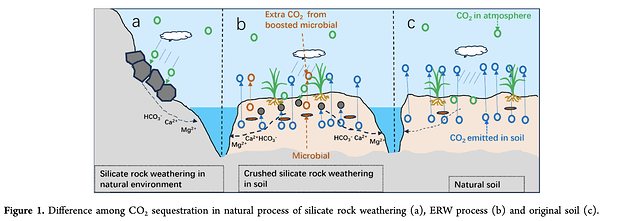Rethinking CO2 Removal Efficiency in Enhanced Rock Weathering
This week, we deep dive into a paper recently published in Environmental Science & Technology. The study was led by Chaoliu Li and Shichang Kang, affiliated to the Department of Earth and Planetary Sciences of the Yale Center for Natural Carbon Capture, in New Haven, Connecticut (United States) and to the State Key Laboratory of Cryospheric Science and Frozen Soil Engineering of the Northwest Institute of Eco-Environment and Resources of the Chinese Academy of Sciences in Lanzhou (China).
This study critically examines the efficiency of Enhanced Rock Weathering (ERW) as a method for atmospheric CO₂ removal. The authors identify and address three key geochemical and mineralogical pitfalls that may lead to an overestimation of ERW’s long-term carbon dioxide removal (CDR) potential. They also provide guidance on how to improve the accuracy of ERW CDR estimates, which is crucial in the context of carbon credits, to ensure the credibility and effectiveness of carbon offset programs.
The study reveals that CDR efficiency estimates could be inflated because of rock powder’s rapid initial dissolution rates, which may not, however, reflect long-term weathering behavior. Moreover, dissolution of accessory carbonates within ERW rock powders can dominate cation and dissolved inorganic carbon fluxes, potentially misattributed to silicate weathering, leading to inflated CDR estimates. Lastly, Methods relying on measuring cations may not accurately represent CO₂ removal, as cation balances often do not align with dissolved inorganic carbon, especially during strong acid weathering.
To enhance the accuracy of ERW CDR estimates, the study recommends: (i) incorporating high-dosage test plots into ERW trials to avoid the reapplication of rock powders that replenish initial fast reactivity; (ii) screening rock powders for carbonate minerals using sensitive techniques to distinguish between carbonate and silicate weathering; (iii) measuring carbon directly to verify CO₂ removal.
Here is a list of the main takeaways of this paper:
- Initial dissolution rates can mislead CDR estimates: Fast-reacting mineral surfaces in fresh rock powders may not represent long-term weathering dynamics.
- Carbonate minerals skew CO₂ removal data: Accessory carbonates dissolve quickly, inflating apparent CDR that isn’t due to silicate weathering.
- Cation-based methods may overestimate CO₂ uptake: Measuring released cations alone doesn’t reliably reflect net carbon sequestration.
- Robust testing protocols are needed: High-dosage trials and mineralogical screening help avoid methodological artifacts and false positives.
- Verifiable carbon measurement is essential: Direct carbon quantification is key for ensuring durability and trust in ERW carbon credits.
Read the full paper here: Rethinking CO2 Removal Efficiency in Enhanced Rock Weathering
